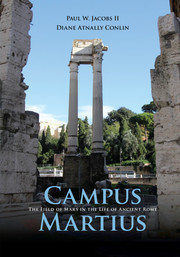Campus Martius The Field of Mars in the Life of Ancient Rome
Langue : Anglais
Auteurs : Jacobs, II Paul W., Conlin Diane Atnally

This book explores the factors that contributed to the transformation of the Campus Martius into a space filled with extraordinary Roman architectural structures.
A mosquito-infested and swampy plain lying north of the city walls, Rome's Campus Martius, or Field of Mars, was used for much of the period of the Republic as a military training ground and as a site for celebratory rituals and occasional political assemblies. Initially punctuated with temples vowed by victorious generals, during the imperial era it became filled with extraordinary baths, theaters, porticoes, aqueducts, and other structures - many of which were architectural firsts for the capitol. This book explores the myriad factors that contributed to the transformation of the Campus Martius from an occasionally visited space to a crowded center of daily activity. It presents a case study of the repurposing of urban landscape in the Roman world and explores how existing topographical features that fit well with the Republic's needs ultimately attracted architecture that forever transformed those features but still resonated with the area's original military and ceremonial traditions.
1. 'The size of the plain is remarkable': defining the limits of the Campus Martius in time and space; 2. Gathering troops in the war god's field; 3. 'Very costly temples': the Campus Martius and republican temple construction; 4. 'Chariot races', 'three theatres', 'an amphitheatre' and more: entertainment in the Campus Martius; 5. 'Colonnades about it in very great numbers': the porticoes of the Campus Martius; 6. Between the Aqua Virgo and the Tiber: water and the Field of Mars; 7. 'A zeal for buildings': reshaping of the space by the emperors; 8. Conclusion: 'the rest of the city a mere accessory'; Appendix A: chronology of development in the Campus Martius to the early fourth century CE; Appendix B: glossary of architectural terms.
Paul W. Jacobs, II is an independent scholar who focuses on ancient Rome and its topographical development. A graduate of Harvard University and the University of Virginia Law School, and a litigator by training, Jacobs has practiced and published in the area of voting rights, where knowledge of demographics, mapmaking and geography is essential. He has spent extensive time in Rome and has been fascinated with the ancient city and its development for decades.
Diane Atnally Conlin is Associate Professor of Classics at the University of Colorado, Boulder. She is author of the award-winning The Artists of the Ara Pacis (1997) and is co-director of the University of Colorado and Comune di Roma excavations at the Villa of Maxentius in Rome. She specializes in the production and style of Roman relief sculpture. In addition to her art historical and archaeological research, Conlin has won numerous teaching awards, including a lifetime appointment as a President's Teaching Scholar.
Diane Atnally Conlin is Associate Professor of Classics at the University of Colorado, Boulder. She is author of the award-winning The Artists of the Ara Pacis (1997) and is co-director of the University of Colorado and Comune di Roma excavations at the Villa of Maxentius in Rome. She specializes in the production and style of Roman relief sculpture. In addition to her art historical and archaeological research, Conlin has won numerous teaching awards, including a lifetime appointment as a President's Teaching Scholar.
Date de parution : 01-2015
Ouvrage de 268 p.
17.8x25.5 cm
Date de parution : 01-2015
Ouvrage de 268 p.
18.3x26 cm
Disponible chez l'éditeur (délai d'approvisionnement : 14 jours).
Prix indicatif 111,55 €
Ajouter au panierThème de Campus Martius :
© 2024 LAVOISIER S.A.S.



